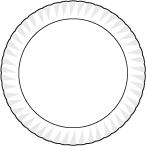Probing What You Cannot See
Astronomers have known for many years that most of the matter (at least
90%, if not more) in the Universe is invisible; we cannot see it; over the
whole range of the electromagnetic spectrum, it does not radiate any light
that we can detect. It is, in effect, "hidden" from our usual ways of
learning about the Universe. Identifying this "dark matter" is a crucial step
in the understanding of the Universe. Whatever it is, dark matter emits no
light, and so, we are left to ask ourselves the following questions: "If
we can't see it, how do we know its there? How
do we know its exact location? How do we determine its mass?"
In this investigation, you will use several methods to determine what
"hidden matter" lies between two paper plates. Through analogies associated
with the cutting-edge research that is now going on with dark matter, you
will uncover the "hidden matter" in your lab.
Materials
- Ruler
- Tape Measure
- Balance or Scale
- Flashlight or strong light source
- Pencil and paper
- Quarter or two
- Two loose paper plates
Procedure
- Determine the mass of the two paper plates and a quarter.
2 Paper Plates _________________ Quarter _________________
- Determine the mass of your "hidden mass" plate. _______________________
- From this, calculate the number of hidden masses you are looking for.
Number of Masses Hidden in the Plates ____________________________
- Hold the missing mass plate near a strong light source, such as a flashlight.
- Locate the positions of the masses. Trace carefully around their
perimeters on the convex paper plate side.
- Measure the distances from the center of the plate to each mass location. Draw the locations and write the distances to each location in the diagram below.

- What pattern do you notice?
__________________________________________________________________
__________________________________________________________________
- Given what you now know, set up a table with the possibilities for the number of masses at each location.
- Place your missing mass plate on the screwdriver such that it is
spin around its center. Is the plate flat or does it tilt to one side? Spin it
around its axis of a few times. Does the same side always stay lower? What
does this tell you about the distribution of mass inside the plate?
- Given your observations, how many of the hidden masses are there in the plates, how many do you now know the locations of, and how many masses are you still looking for?
____________________________________________________________
____________________________________________________________
- Use your extra quarters and your table of possibilities for the number of masses at each location to reveal the hidden mass(es). How will you know when you have discovered the missing mass distribution?
____________________________________________________________
____________________________________________________________
- Draw the locations and original mass distribution at each location in the diagram below.

Analyze and Reflect:
Just like this lab, all of astronomy involves indirect measures and
investigations. It would have been very easy for us to tear apart the
paper plate in order to discover how much "hidden matter" there was and
where it was located. Everyday, scientists wish they could do that very
thing to the Universe! Alas, they cannot. So when we study a subject such
as dark matter, it is important to understand the tools at hand to probe its
nature -- since we cannot just take the easy way out!
- When you took a total mass measurement of the "hidden matter" in the paper plates, it was just like you were a scientist at NASA who had taken total mass measurements from gravitational binding of clusters.
- When the light was shone through the paper plate to locate the "hidden
matter", it was as if you were applying the concept of gravitational lensing to locate dark matter as at Bell Labs scientists have done.
- Lastly, you can think of balancing torques in paper plates as analogous to the rotational curve observations of galaxies that is being done now to reveal even more about dark matter.
Think about this lab and the studies that are being done right now on dark
matter. What has this lab taught you about the scientific approach to
revealing the nature of dark matter? Discuss below.
This site currently under
construction to become 508 compliant.
